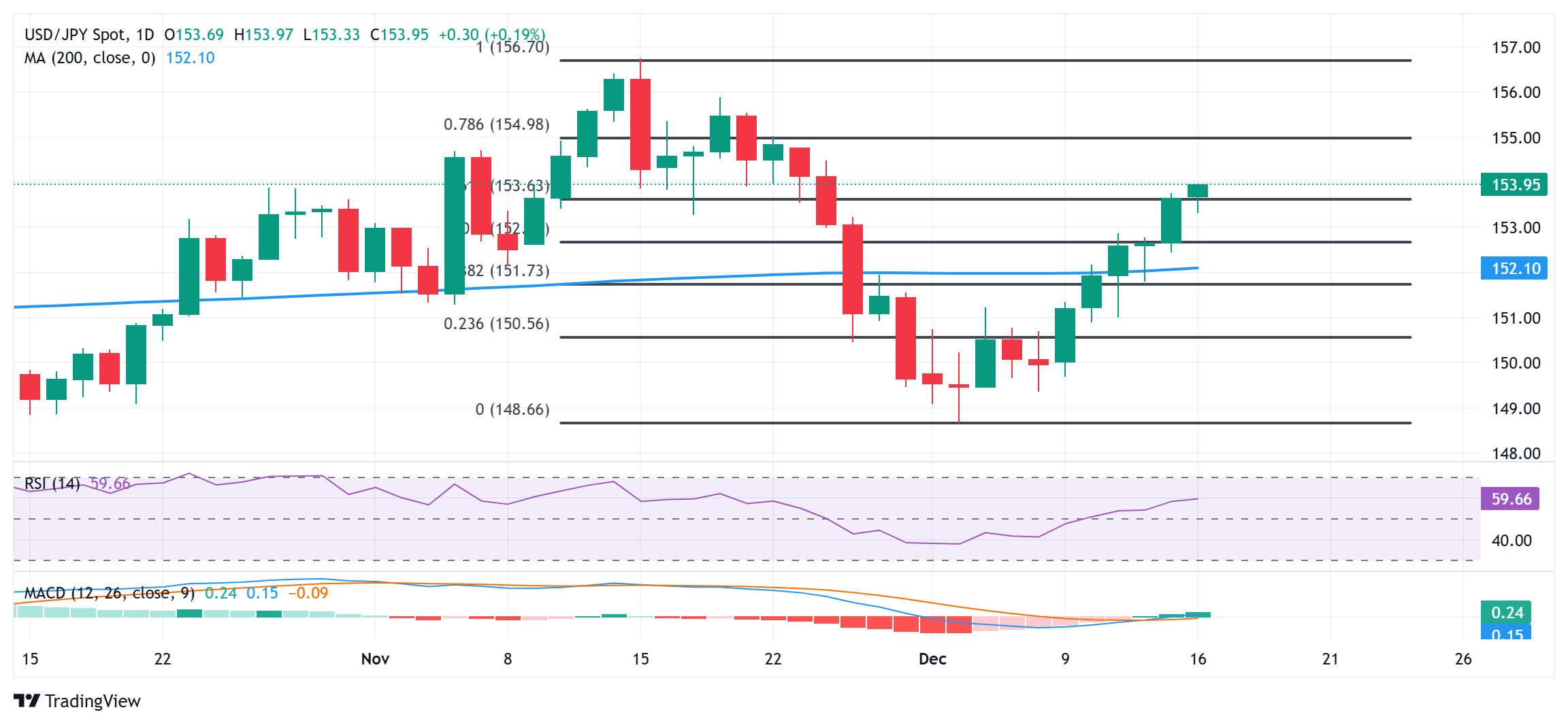- The Japanese Yen drifts decrease towards its American counterpart for the sixth straight day.
- Expectations that the BoJ will preserve charges regular this week proceed to weigh on the JPY.
- Elevated US bond yields contribute to driving flows away from the lower-yielding JPY.
The Japanese Yen (JPY) continues shedding floor towards its American counterpart on Monday and drops to a three-week low in the course of the Asian session. Regardless of the better-than-expected launch of Core Equipment Orders and flash Manufacturing PMI from Japan, expectations that the Financial institution of Japan (BoJ) is not going to increase rates of interest later this week proceed to undermine the JPY. Moreover, bets for a much less dovish Federal Reserve (Fed) stay supportive of elevated US Treasury bond yields, which develop into one other issue undermining the lower-yielding JPY.
That stated, persistent geopolitical dangers stemming from the protracted Russia-Ukraine warfare and the continued conflicts within the Center East, together with issues about US President-elect Donald Trump’s tariff plans, might provide help to the safe-haven JPY. Merchants may also chorus from putting aggressive directional bets forward of this week’s key central financial institution occasion dangers. The Fed is scheduled to announce its determination on the finish of a two-day assembly on Wednesday, which shall be adopted by the essential BoJ assembly on Thursday. Buyers will search for cues in regards to the rate of interest outlook within the US and Japan, which, in flip, will decide the near-term trajectory for the USD/JPY pair.
Japanese Yen promoting bias stays unabated amid BoJ charge hike skepticism
- Authorities information launched earlier this Monday confirmed that Japan’s core equipment orders rose 2.1% in October and registered a powerful progress of 5.6% on a year-on-year foundation.
- The au Jibun Financial institution Japan Manufacturing Buying Managers’ Index (PMI) improved to 49.5 in December, although remained in contraction territory for the seventh straight month.
- In the meantime, the gauge for the companies sector rose to 51.4 in December from 50.5, whereas the composite PMI stood at 50.8 in the course of the reported month, up from 50.1 in November.
- This comes after the Financial institution of Japan’s Tankan survey confirmed on Friday that enterprise confidence at Japan’s massive producers improved in the course of the three months to December.
- Furthermore, expectations that client costs in Japan will stay above the BoJ’s 2% goal, a reasonably increasing economic system and an increase in wages give the BoJ motive to hike charges.
- Buyers, nonetheless, stay sceptical concerning the BoJ’s intention to tighten its financial coverage additional, which continues to exert downward stress on the Japanese Yen on Monday.
- The yield on the benchmark 10-year US authorities bond rose to a three-week excessive on Friday amid rising bets that the Federal Reserve will undertake a cautious stance on slicing charges.
- In accordance with the CME Group’s FedWatch Device, merchants are pricing in over a 93% probability that the US central financial institution will decrease borrowing prices once more, by 25 foundation factors on Wednesday.
- Nevertheless, indicators that the progress in reducing inflation towards the US central financial institution’s 2% goal has stalled raised the opportunity of a slower tempo of rate of interest reductions subsequent 12 months.
- Monday’s US financial docket options the discharge of the flash Manufacturing and Companies PMIs, together with the Empire State Manufacturing Index, later in the course of the US session.
- That stated, the market focus stays glued to the essential FOMC and the BoJ conferences this week, which can assist in figuring out the near-term trajectory for the USD/JPY pair.
USD/JPY transfer above 61.8% Fibo. degree units the stage for extra positive factors

From a technical perspective, a sustained transfer and acceptance above the 61.8% Fibonacci retracement degree of the November-December fall from a multi-month peak might be seen as a contemporary set off for bulls. Furthermore, oscillators on the each day chart have simply began gaining constructive traction and recommend that the trail of least resistance for the USD/JPY pair stays to the upside. Therefore, some follow-through energy in direction of the subsequent related hurdle, across the 154.55 area, en path to the 155.00 psychological mark, seems like a definite chance.
On the flip facet, the Asian session low, across the 153.35-153.30 space, now appears to behave as a right away robust help forward of the 153.00 mark. A convincing break beneath the latter may expose the essential 200-day Easy Shifting Common (SMA) pivotal help close to the 152.10-152.00 area. A convincing break beneath the latter may shift the bias in favor of bearish merchants and drag the USD/JPY pair in direction of the 151.00 spherical determine en path to the 150.00 psychological mark.
Financial institution of Japan FAQs
The Financial institution of Japan (BoJ) is the Japanese central financial institution, which units financial coverage within the nation. Its mandate is to challenge banknotes and perform foreign money and financial management to make sure value stability, which suggests an inflation goal of round 2%.
The Financial institution of Japan embarked in an ultra-loose financial coverage in 2013 as a way to stimulate the economic system and gas inflation amid a low-inflationary surroundings. The financial institution’s coverage is predicated on Quantitative and Qualitative Easing (QQE), or printing notes to purchase belongings corresponding to authorities or company bonds to supply liquidity. In 2016, the financial institution doubled down on its technique and additional loosened coverage by first introducing adverse rates of interest after which instantly controlling the yield of its 10-year authorities bonds. In March 2024, the BoJ lifted rates of interest, successfully retreating from the ultra-loose financial coverage stance.
The Financial institution’s large stimulus triggered the Yen to depreciate towards its important foreign money friends. This course of exacerbated in 2022 and 2023 on account of an rising coverage divergence between the Financial institution of Japan and different important central banks, which opted to extend rates of interest sharply to battle decades-high ranges of inflation. The BoJ’s coverage led to a widening differential with different currencies, dragging down the worth of the Yen. This development partly reversed in 2024, when the BoJ determined to desert its ultra-loose coverage stance.
A weaker Yen and the spike in international vitality costs led to a rise in Japanese inflation, which exceeded the BoJ’s 2% goal. The prospect of rising salaries within the nation – a key factor fuelling inflation – additionally contributed to the transfer.
